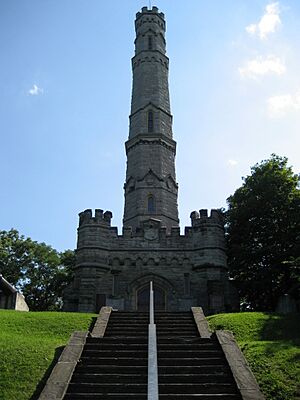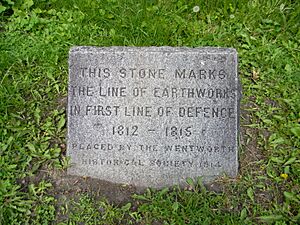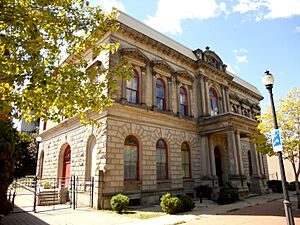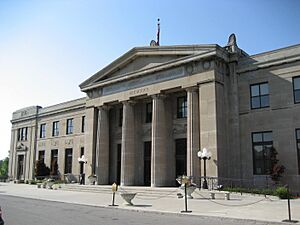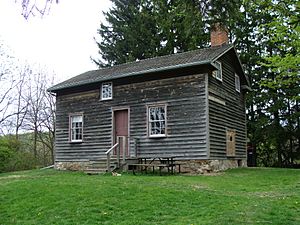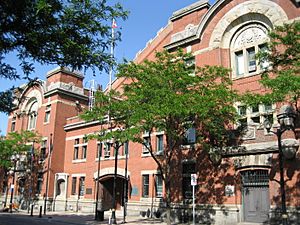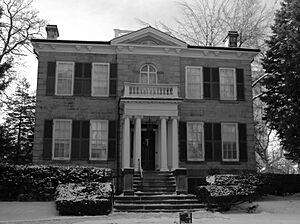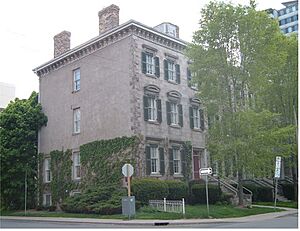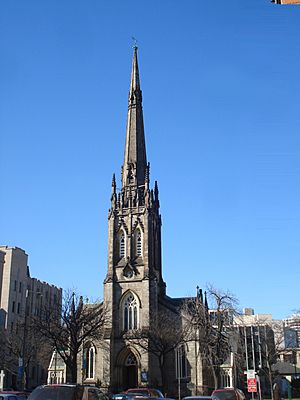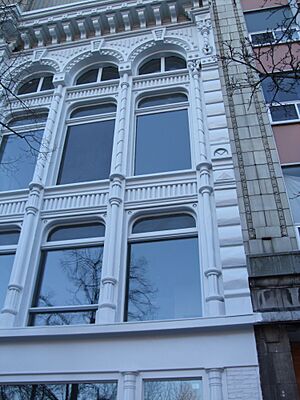List of National Historic Sites of Canada in Hamilton, Ontario facts for kids
Hamilton, Ontario, is home to many important places that tell stories about Canada's past. These special spots are called National Historic Sites. There are 15 of these sites in Hamilton. One of them, the HMCS Haida, is looked after by Parks Canada, a government group that protects Canada's natural and historic treasures.
The very first site in Hamilton to be named a National Historic Site was Burlington Heights in 1929. Besides sites, there are also "National Historic Events" and "National Historic Persons" recognized in Hamilton, often marked with special plaques. These plaques help us remember important moments and people from history.
Contents
- National Historic Sites in Hamilton
- Battle of Stoney Creek
- Burlington Heights
- Dundurn Castle
- Erland Lee (Museum) Home
- Former Hamilton Customs House
- Former Hamilton Railway Station (Canadian National)
- Griffin House
- Hamilton Waterworks
- HMCS Haida
- John Weir Foote Armoury
- McQuesten House / Whitehern
- Royal Botanical Gardens
- Sandyford Place
- St. Paul's Presbyterian Church / Former St. Andrew's Church
- Victoria Hall
- See also
National Historic Sites in Hamilton
Battle of Stoney Creek
The Battle of Stoney Creek site marks a key moment in the War of 1812. In 1813, a British victory here stopped American forces from advancing further into Canada. It was a major turning point in the Niagara campaign during the war.
Burlington Heights
Burlington Heights was a crucial spot during the War of 1812. From 1813 to 1814, it served as a meeting point and supply base for defending the Niagara area and supporting the navy on Lake Ontario.
Dundurn Castle
Completed in 1835, Dundurn Castle is a beautiful villa built in a "picturesque" style. It was once the home of Sir Allan Napier MacNab, a very important person in Canadian history. Today, it's a popular museum.
Erland Lee (Museum) Home
The Erland Lee Home, finished in 1808, is a unique farmhouse. It's famous because the first ever Women's Institute constitution was written here. This was a big step for women's movements both in Canada and around the world.
Former Hamilton Customs House
Built in 1860, the Former Hamilton Customs House was where goods entering Canada were checked. It's a great example of Italianate architecture, a popular building style in Canada from the 1840s to the 1870s. Today, it's the Workers Arts and Heritage Centre.
Former Hamilton Railway Station (Canadian National)
The Former Hamilton Railway Station (Canadian National), completed in 1931, was built by the Canadian National Railway. It's a rare example of a railway station from between the World Wars that followed the "City Beautiful movement" design ideas. It was also a vital entry point for immigrants after World War II.
Griffin House
Griffin House, finished in 1827, is a rare example of a four-room house from the early 1800s in Upper Canada. It was owned by Enerals Griffin, an Black immigrant from Virginia who settled there in 1834. This house is connected to the history of Black settlement in British North America and the Underground Railroad.
Hamilton Waterworks
The Hamilton Waterworks, completed in 1859, was built to provide clean water for drinking and fighting fires in Hamilton, which was growing quickly. It's a rare and well-preserved example of a Victorian industrial complex that still looks and works much like it did originally.
HMCS Haida
The HMCS Haida is the last surviving "Tribal-class" destroyer from World War II. Built in 1942, this ship is now a museum ship docked in Hamilton Harbour, where people can visit and learn about its history. It's administered by Parks Canada ![]() .
.
John Weir Foote Armoury
The John Weir Foote Armoury, completed in 1888, is named after John Weir Foote. The northern part of this building shows how drill halls were built in Canada between the 1870s and 1890s.
McQuesten House / Whitehern
McQuesten House / Whitehern, finished in 1848, is a two-story home built in the neoclassical style. It was the home of Thomas McQuesten and is now a museum. It's a great example of a mid-19th-century house in Ontario that is still in excellent condition.
Royal Botanical Gardens
Established in the 1920s, the Royal Botanical Gardens covers about 1,100 hectares around Burlington Bay. It's one of Canada's most important botanical gardens. It's also known internationally for its work with lilacs and for its efforts in plant conservation.
Sandyford Place
Sandyford Place, completed in 1856, is a row of stone terrace houses. This style was common in Hamilton when many Scottish settlers wanted to build homes similar to those in Scottish towns. It's a good example of housing built for merchants in the mid-1800s.
St. Paul's Presbyterian Church / Former St. Andrew's Church
St. Paul's Presbyterian Church, finished in 1857, is a wonderful example of the Gothic Revival style. It's a beautiful small church in the city.
Victoria Hall
Victoria Hall, completed in 1888, is a three-and-a-half-story commercial building. It has a very rare, hand-made, galvanized sheet-metal front on its upper floors. It's one of the most impressive surviving sheet metal facades in Canada.
See also


